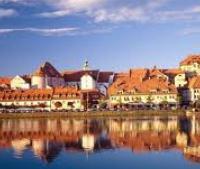
Great Tournaments of the Past- New York 1924
Nowadays chess sponsorship seems to be in crisis and many strong tournaments are being cancelled. However, some of those glorious events that put our sport in the spotlight will live forever. There are various reasons for this phenomenon: one of them is the rich character of the tournament battle, the glorious chess that the participants showed throughout the whole event which resulted in a variety of chess masterpieces, the motion that those events gave to the development of chess. Last, but not least, those tournaments were described in great mastery by great players.
 One such marvelous event happened to be the New York tournament in 1924, which was covered in an excellent tournament book by future World Champion Alexander Alekhine.
One such marvelous event happened to be the New York tournament in 1924, which was covered in an excellent tournament book by future World Champion Alexander Alekhine.
In December 1923 the interest towards chess in the USA reached its peak thanks to the presence and remarkable achievements of Alexander Alekhine. The Russian player was not yet world champion but with his colourful and aggressive play entertained the whole chess world.
Organizing such an event was never an easy task, and in this case the participants had to travel for weeks to reach the USA from Europe by ships, as aircraft were still in development. Still, the tournament managed to attract almost all the best players of the time, including the reigning world champion Jose Raul Capablanca, his predecessor- Dr. Emanuel Lasker, Alekhine himself, and eight more top Grandmasters, who competed in a double round-robin event.
 The sensation of the first round was Capablanca’s defeat by Richard Reti (the World Champion had not lost a game since 1916 and was practically considered untouchable).
The sensation of the first round was Capablanca’s defeat by Richard Reti (the World Champion had not lost a game since 1916 and was practically considered untouchable).
The Czech maestro for his part made one of his most colourful tournaments ever. He introduced the opening with a double fianchettoe, which still carries his name and gave impact to Hypermodernism in chess; he also won fifth place overall and claimed first prize for the most beautiful game:
Second best game prize went to American champion Frank Marshall for his effort against Efim Bogoljubow:
The third best game had important sporting meaning as it was played between the two top finishers:
Despite this win, the world champion could not catch up with the 56-year old Dr. Lasker. The former champion won 13 out of the 20 (!) games which he played to win the event outright- 16/20. Capablanca also lost only one game, but was far less productive- 14.5, while Alekhine confirmed his high status with a third place, scoring 12 points.
The tournament was more than well attended and the ticket income from the spectators was in excess of 3500 $- a huge sum for the time. There could have been even more had the venue been bigger.
The event was crowned by Alekhine’s deep annotations in a book that is still popular and well received by chess society. Chess was still very Classical, and Capablanca’s opening choice as Black against Eduard Lasker- 1.e4 g6 was called by Alekhine: “a joke.”



